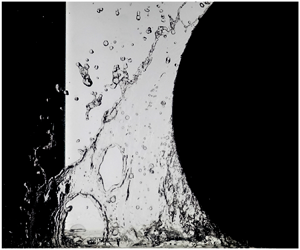Published online by Cambridge University Press: 03 December 2020

The so-called Landau–Levich–Deryaguin problem treats the coating flow dynamics of a thin viscous liquid film entrained by a moving solid surface. In this context, we use a simple experimental set-up consisting of a partially immersed rotating disc in a liquid tank to study the role of inertia, and also curvature, on liquid entrainment. Using water and UCON $^{\textrm{TM} }$ mixtures, we point out a rich phenomenology in the presence of strong inertia: ejection of multiple liquid sheets on the emerging side of the disc, sheet fragmentation, ligament formation and atomization of the liquid flux entrained over the disc's rim. We focus our study on a single liquid sheet and the related average liquid flow rate entrained over a thin disc for various depth-to-radius ratio
$^{\textrm{TM} }$ mixtures, we point out a rich phenomenology in the presence of strong inertia: ejection of multiple liquid sheets on the emerging side of the disc, sheet fragmentation, ligament formation and atomization of the liquid flux entrained over the disc's rim. We focus our study on a single liquid sheet and the related average liquid flow rate entrained over a thin disc for various depth-to-radius ratio  $h/R < 1$. We show that the liquid sheet is created via a ballistic mechanism as liquid is lifted out of the pool by the rotating disc. We then show that the flow rate in the entrained liquid film is controlled by both viscous and surface tension forces as in the classical Landau–Levich–Deryaguin problem, despite the three-dimensional, non-uniform and unsteady nature of the flow, and also despite the large values of the film thickness based flow Reynolds number. When the characteristic Froude and Weber numbers become significant, strong inertial effects influence the entrained liquid flux over the disc at large radius-to-immersion-depth ratio, namely via entrainment by the disc's lateral walls and via a contribution to the flow rate extracted from the three-dimensional liquid sheet itself, respectively.
$h/R < 1$. We show that the liquid sheet is created via a ballistic mechanism as liquid is lifted out of the pool by the rotating disc. We then show that the flow rate in the entrained liquid film is controlled by both viscous and surface tension forces as in the classical Landau–Levich–Deryaguin problem, despite the three-dimensional, non-uniform and unsteady nature of the flow, and also despite the large values of the film thickness based flow Reynolds number. When the characteristic Froude and Weber numbers become significant, strong inertial effects influence the entrained liquid flux over the disc at large radius-to-immersion-depth ratio, namely via entrainment by the disc's lateral walls and via a contribution to the flow rate extracted from the three-dimensional liquid sheet itself, respectively.
A water sheet extending perpendicularly outward from the rim is ejected on the emerging side of a partially-submerged rotating wheel of radius 13.5 cm when depth-to-radius ratio of 0.2.
Holes nucleate, grow and disintegrate the water sheet on the emerging side of the wheel. This leads to ligaments and droplets ejected at the liquid rim.
Rim of the rotating disk for UCON (nearly 100 times more viscous than water) at 19 rpm and depth-to-radius ratio of 0.2.
A typical inertial liquid sheet for UCON (nearly 100 times more viscous than water) of a rotating wheel of radius 21 cm at 65 rpm and depth-to-radius ratio of 0.2.
Instantaneous visualization of sheet and entrained film thickness for a rotating wheel of diameter 42 cm and depth-to-radius ratio 0.43 at 3.5 m/s. The video shows relatively large variations of the film thickness, both locally and temporally.